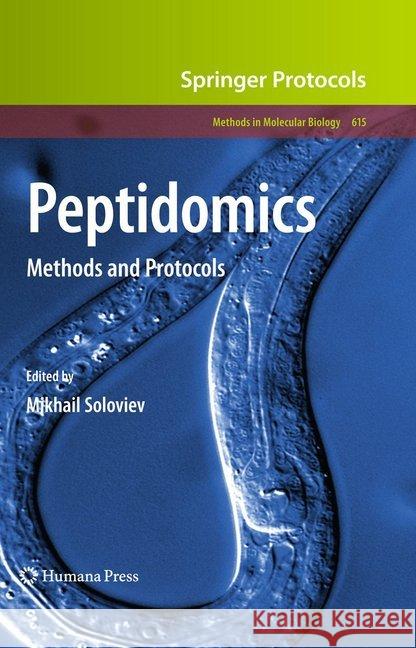Peptidomics: Methods and Protocols » książka



Peptidomics: Methods and Protocols
ISBN-13: 9781493957293 / Angielski / Miękka / 2016 / 395 str.
Peptidomics: Methods and Protocols
ISBN-13: 9781493957293 / Angielski / Miękka / 2016 / 395 str.
(netto: 403,88 VAT: 5%)
Najniższa cena z 30 dni: 421,13 zł
ok. 20 dni roboczych.
Darmowa dostawa!
This book presents a comprehensive range of analytical techniques for the analysis of the peptide contents of complex biological samples. The book includes all peptidomic methods in a single volume and covers a wide range of species from bacterial to man.
From the reviews:
"Peptidomics-Methods and Protocols focuses on high-throughput techniques for the analysis of peptidomes from a wide range of biological systems ... . The procedures covered in this book encompass a number of model and non-model organisms, and most chapters have been written by distinguished researchers who have made major contributions to their respective fields. Peptidomics-Methods and Protocols is an indispensable reference book for specialists, but also an introductory work for newcomers to the rapidly developing discipline of peptidomics." (Juan J. Calvete, Analytical and Bioanalytical Chemistry, Vol. 398, September, 2010)
"The editor and co-authors of this volume must be congratulated on a comprehensive collection of very diverse peptidomics protocols that serve as an excellent introduction for a novice in this field. At the same time, the book provides the expert researcher with highly detailed experimental procedures and practical advice for the analysis of complex mixtures of peptides from a variety of sources. I warmly recommend this book to anyone interested in the field of peptidomics." (Christian A. Olsen, ChemBioChem, Vol. 11, August, 2010)
Part I: Introduction 1. Peptidomics: Divide et Impera Mikhail Soloviev Part II: From Bacteria to Men 2. Performing Comparative Peptidomics Analyses of Salmonella from Different Growth Conditions Joshua N. Adkins, Heather Mottaz, Thomas O. Metz, Charles Ansong, Nathan P. Manes, Richard D. Smith, and Fred Heffron 3. Approaches to Identify Endogenous Peptides in the Soil Nematode Caenorhabditis elegans Steven J. Husson, Elke Clynen, Kurt Boonen, Tom Janssen, Marleen Lindemans, Geert Baggerman, and Liliane Schoofs 4. Mass Spectrometric Analysis of Molluscan Neuropeptides Ka Wan Li and August B. Smit 5. Monitoring Neuropeptides in vivo via Microdialysis and Mass Spectrometry Heidi L. Behrens and Lingjun Li 6. Protocols for Peptidomic Analysis of Spider Venoms Liang Songping 7. Purification and Characterization of Biologically Active Peptides from Spider Venoms Alexander A. Vassilevski, Sergey A. Kozlov, Tsezi A. Egorov, and Eugene V. Grishin 8. MALDI-TOF Mass Spectrometry Approaches to the Characterization of Insect Neuropeptides Robert J. Weaver and Neil Audsley 9. Direct MALDI-TOF Mass Spectrometric Peptide Profiling of Neuroendocrine Tissue of Drosophila Christian Wegener, Susanne Neupert, and Reinhard Predel 10. Direct Peptide Profiling of Brain Tissue by MALDI-TOF Mass Spectrometry Joachim Schachtner, Christian Wegener, Susanne Neupert, and Reinhard Predel 11. Peptidomic Analysis of Single Identified Neurons Susanne Neupert and Reinhard Predel 12. Identification and Analysis of Bioactive Peptides in Amphibian Skin Secretions J. Michael Conlon and Jérôme Leprince 13. An Efficient Protocol for DNA Amplification of Multiple Amphibian Skin Antimicrobial PeptidecDNAs Shawichi Iwamuro and Tetsuya Kobayashi 14. Combined Peptidomics and Genomics Approach to the Isolation of Amphibian Antimicrobial Peptides Ren Lai 15. Identification and Relative Quantification of Neuropeptides from the Endocrine Tissues Kurt Boonen, Steven J. Husson, Bart Landuyt, Geert Baggerman, Eisuke Hayakawa, Walter H.M.L. Luyten, and Liliane Schoofs 16. Peptidome Analysis of Mouse Liver Tissue by Size Exclusion Chromatography Prefractionation Lianghai Hu, Mingliang Ye, and Hanfa Zou 17. Rat Brain Neuropeptidomics: Tissue Collection, Protease Inhibition, Neuropeptide Extraction, and Mass Spectrometric Analysis Robert M. Sturm, James A. Dowell, and Lingjun Li 18. Quantitative Neuroproteomics of the Synapse Dinah Lee Ramos-Ortolaza, Ittai Bushlin, Noura Abul-Husn, Suresh P. Annagudi, Jonathan Sweedler, and Lakshmi A. Devi 19. Peptidomics Analysis of Lymphoblastoid Cell Lines Anne Fogli and Philippe Bulet 20. Peptidomics: Identification of Pathogenic and Marker Peptides Yang Xiang, Manae S. Kurokawa, Mie Kanke, Yukiko Takakuwa, and Tomohiro Kato Part III: Tools and Approaches 21. Peptidomic Approaches to the Identification and Characterization of Functional Peptides in Hydra Toshio Takahashi and Toshitaka Fujisawa 22. Immunochemical Methods for the Peptidomic Analysis of Tachykinin Peptides and their Precursors Nigel M. Page and Nicola J. Weston-Bell 23. Affinity Peptidomics: Peptide Selection and Affinity Capture on Hydrogels and Microarrays Fan Zhang, Anna Dulneva, Julian Bailes, and Mikhail Soloviev 24. In situ Biosynthesis of Peptide Arrays Mingyue He and Oda Stoevesandt 25. Bioinformatic Approaches to the Identification of Novel Neuropeptide Precursors Elke Clynen, Feng
Despite being known and studied for years, peptides have never before attracted enough attention to necessitate the invention of the term "peptidomics" in order to specify the study of the complement of peptides from a cell, organelle, tissue or organism. In Peptidomics: Methods and Protocols, expert researchers present a comprehensive range of analytical techniques for the analysis of the peptide contents of complex biological samples with an emphasis often on higher throughput techniques, suitable for the analysis of large numbers of peptides typically present in the peptidomes. Encompassing a number of species ranging from bacteria to man, the methods presented intensively cover topics such as organism handling, tissue and organ dissection, cellular and subcellular fractionation, peptide extraction, fractionation and purification, structural characterization, molecular cloning, and sequence analysis. Written in the highly successful Methods in Molecular Biology™ series format, chapters include introductions to their respective topics, lists of the necessary materials and reagents, step-by-step, readily reproducible laboratory protocols, and notes on troubleshooting and avoiding known pitfalls.
Comprehensive and cutting-edge, Peptidomics: Methods and Protocols brings this ten year old field fully up-to-date in order to inspire novices and experts alike with the easy-to-follow practical advice needed to set up and carry out analysis of the peptide contents of complex biological samples.
1997-2025 DolnySlask.com Agencja Internetowa
KrainaKsiazek.PL - Księgarnia Internetowa









